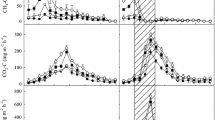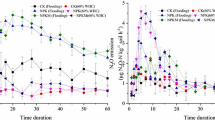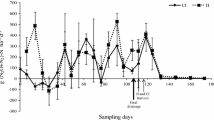Abstract
This research aims at elucidating the greenhouse gas emissions and its related soil microbial properties in continuously flooded or intermittently drained paddy soils in Japan and Indonesia. The study in Japan comprises alluvial soil and peat, cultivated to rice variety Nipponbare, while in Indonesia comprised alluvial soil cultivated to rice variety Siam Pandak. Intermittent drainage was performed to half number of the plot in 6 days interval, starting at tillering or heading stage of rice, while the other half number of plot was kept flooded as control. The experiments were carried out to follow the randomized block design with three replications. Gas samples were taken in weekly basis, except during the treatments (i.e., every 2 days interval) and analyzed for methane (CH4) and nitrous oxide (N2O) concentrations. Soil samples were and analyzed for the population of methanogenic bacteria, denitrifiers, methane production and consumption potentials, and methanogenic substrate. Plant growth parameters were also observed. The results showed that intermittent drainage significantly reduced greenhouse gas emission from paddy soil of Indonesia and Japan without significant changes in soil microbial population. The reductions of greenhouse emission from Japanese peaty and alluvial paddy soil due to intermittent drained were about 32 and 37%, respectively. Meanwhile, the reductions in greenhouse gas emission from alluvial soil of Indonesia due to intermittent drainage were very similar to that of in Japan, i.e., average about 37%. This suggests that intermittent drainage can be an appropriate technology option to reduce the greenhouse gas emission from paddy soil in Japan and Indonesia.
Similar content being viewed by others
Explore related subjects
Discover the latest articles, news and stories from top researchers in related subjects.Avoid common mistakes on your manuscript.
Introduction
At the 15th Conference of Parties of United Nation Forum on Climate Change, 25 and 26% reductions of greenhouse gas emissions were aimed by Indonesia and Japan, respectively (http://news.bbc.co.uk/2/hi/science/nature/82410). To achieve the target, both countries have been attempting to invent, search, and implement technologies relevant to reductions of greenhouse gas emissions from contributing sectors.
Paddy field is considered as a significant source of methane (CH4) and nitrous oxide (N2O) emissions, two greenhouse gases, which have attracted considerable attention during the last decades because of their contribution to global warming (Harris et al. 1985; Bouwman 1990). Methane is produced by methanogens during organic matter decomposition, under an environment where the oxygen (O2) and sulfate (SO4 2−) are scarce (Bouwman 1990; Cicerone and Oremland 1988). Nitrous oxide is produced microbiologically during the anaerobic conditions of paddy soils (IPCC 2001; Mosier et al. 1996). The development of efficient irrigation water management would minimize the emission of these gases from paddy soil.
Intermittent drainage has been proposed as a recommended water management to reduce CH4 emission from paddy soil (Boundia et al. 1996), intermittent drainage is also needed to remove hazardous organic compound in rice rhizosphere and to increase the availability of some nutrients (Miyake 1982). However, Nugroho et al. (1994) reported that intermittent drainage did not affect CH4 emission or, inversely, some time emitted more CH4 compared to continuously flooded soils in Indonesia. In case of N2O, draining paddy soil prior to harvesting increased N2O emission (Tsuruta et al. 1995).
There is a lack of information on the effect of intermittent drainage on the CH4 and N2O emissions from Indonesian paddy fields. The processes controlling the dynamics of CH4 and N2O under intermittent drainage are also poorly understood. Therefore, this research aims at elucidating the greenhouse gas emissions and its related soil microbial properties in continuously flooded or intermittent drained paddy soils in Japan and Indonesia.
Materials and methods
The study in Japan comprised peat and alluvial soils, while in Indonesia comprised alluvial soil. The soil characteristics are given in Table 1.
Site in Indonesia situated in catchments area of Barito River and its sub-catchments area comprised alluvial soil. Peat was taken from Togane city, situated in the back-swamp of natural sand dune formed by the Pacific Ocean of Chiba Prefecture, Japan. The peat layers are buried at the depth of 50 cm because of the soil dressing practice in the area for long time (Dr. T. Anzai, Chiba Prefec. Res. Station, Pers. Commun.), the area is now used for rice and vegetable cultivation. Meanwhile, an alluvial soil in Kuzukuri city, located on the beach of the Pacific Ocean site in Chiba Prefecture, Japan was also taken. This area is dominated by sandy soil and cultivated to rice and vegetable crops (Fig. 1).
Experiment in Indonesia
To study the effect of water management on CH4 and N2O emissions in Indonesia, six plots each measuring 4 m × 5 m established at a farm in Sungai Rangas, South Kalimantan, by constructing a risen soil bed in between the plots. The plots were plowed up to 25 cm depth at late rainy season 2004 and arranged to follow randomized block design with three replications. Chopped rice straw equivalent to 4 ton ha−1 was incorporated into the soil. Basal fertilizers in the form of urea, SP-36, and KCl were applied at rate of 100 kg ha−1 N, P2O5 and K2O. Eh electrode then inserted in the soil up to 5 cm depth.
All pots were planted with rice seedling local variety Siam Pandak, which had been nursed for 21 days. In each plot, one hill containing three seedlings was transplanted spacing at 25 cm × 25 cm. At the same time, Eh electrodes were inserted into 5, 10, or 15 cm soil depths. The intermittent drainage in the three plots was conducted for 7 days interval, starting at the heading stage of rice until harvesting. The other three plots were kept flooded as control treatment. Soil samples were taken from three soil depths (i.e., 0–5, 5–10, 10–15, and 15–20 cm) at harvesting and used for determination of methanogenic and denitrifying bacterial population. The same plots were again used in dry season of year 2004 and rainy season of 2005. All materials and methods are the same with previous crop season, except that rice variety Margasari was grown at rainy crop season and microbial determinations were excluded.
Gas samples were collected in monthly bases until harvesting, except during the intermittent treatment when the gas samples were taken in every 2 days. Methane and N2O fluxes were determined with chamber method. A chamber (50 cm wide, 50 cm length, and 50 or 100 cm height) was gently placed in order to enclose four rice plants. Gas samples were taken through capillary tube on the top of chamber with plastic syringe. Methane and N2O concentrations were determined by a gas chromatograph (Shimadzu, GC-7A) equipped with FI or EC detectors, a gas sampler with 1 ml volume tube and an integrator (Shimadzu, C-R2A). The working conditions for the gas chromatography were as that described by Hadi et al. (2005).
The flux was calculated from temporal increase of the gas concentration inside the chamber with time. The emissions of greenhouse gases were calculated by integrating the fluxes with the duration of experiment (Yagi, 1997). Global warming potential (GWP) was calculated based on formula:
The population of methanogenic bacteria was estimated by method described by Asakawa et al. (1997) with some modifications. Briefly, 5 ml of soil was taken into a 100 ml BOD bottle containing 45 ml ringer’s solution under O2-free N2. Sample was then shaken for 15 min on mechanical shaker. Ten fold dilution series with five replicates were prepared, stopping at 10−7. Using sterile automatic pipette, 1 ml appropriate dilution was transferred into incubation tube (serum tube of 18 mm × 180 mm) containing 9 ml medium. The tubes were then placed in the dark at 25°C for 8 weeks. Each tube was examined for growth of methanogens at 4 and 8 weeks of incubation. The growth of each tube was recorded and the population of methanogens was then calculated by multiplying the dilution factor.
The population of denitrifying bacteria was counted by most probable number (MPN) method as described by Alexander (1982). In this method, 9 ml of medium was placed in incubation tube (No. 14). Twenty-five tubes were prepared for each sample. A Durham vial was withdrawn upside down. The tubes were then autoclaved at 121°C for 15 min. Using sterile automatic pipette, 1 ml of the appropriate dilution was inoculated after the medium was allowed to cool. The tubes were then placed in the dark at 30°C for 8 weeks. The positive tubes (i.e., tubes with gas bubble) were considered and the number of denitrifiers was computed on MPN tables.
Experiment in Japan
To compare the CH4 and N2O emission in alluvial soil with other soil, 2 kg of peat and 4 kg of alluvial soils were filled in plastic pots measuring 0.02 m−2 (16 cm diameter, 20 cm height) in Japan. The pot arrangements and cultivation practices were the same as for previous experiment. After rice seedling variety Nipponbare were transplanted, the pots were placed in a glass house. The pots were flooded by daily watering to keep water level at 2–5 cm depth until the time of treatment. Three pots of each treatment were prepared and used for gas and Eh measurement. Another three pots were prepared and kept in the same manner as for gas measurement and used for the determination of methane production and oxidation potentials and methanogenic bacterial population. The drainage was performed for 6 days by opening the stop cock in the bottom of the pot. Drained water was collected and analyzed for organic carbon content.
Methane and N2O fluxes were determined with the same method as previously described. Methane production potential was estimated by incubation method described by Chithaisong et al. (1996). Methane oxidation activity was estimated by using propylene alternative substrate method (Watanabe et al. 1997). The plant root and plant above ground biomass and grain yield were also determined.
Statistical analyses
All statistical analyses were performed using the “SYSTAT 8.0” statistical package (SPSS 1996). The frequency distributions of all data were first tested for normality using Lilliefors Test. If normally distributed, differences between treatment were determined by analysis of variance (ANOVA) and least significant differences (LSD) test. All statistical considerations were based on P < 0.05 significant level.
Results and discussion
The averaged CH4 emission from intermittently drained plot in Indonesia was 1,384 kg C ha−1 season−1, while from continuously flooded plot was 1,137 kg C ha−1 season−1. The averaged N2O emissions from those plots were 1.97 and −19.7, respectively. The CO2 emissions from both treatments were similar. In total (years 2004–2005), the reduction in global warming potential from paddy field of Indonesia due to water management was about 37% (Table 2). This indicates that water management can be an efficient technique to reduce greenhouse gas emission from Indonesian paddy field.
Water management did not significantly affect the population of either methanogenic bacteria or denitrifying bacteria. Only soil depth affected the population of denitrifying bacteria, with the lowest number in the lowest position of sample source (i.e., 15–20 cm soil depth) (Table 3). Luck in statistical differences was probably due to the high variability of bacterial data. Similar reason can be also applied to the gas data obtained from field experiment (Table 2). This problem has been also encountered by other researchers (Moore and Knowles 1990; Furukawa et al. 2005).
Data on Eh showed that the Eh in intermittently drained plot were higher than that of continuously flooded plot particularly at late stage of rice growth (Fig. 2). This can be the reason for the reduction in CH4 emission from intermittently drained paddy field. High Eh values prevent CH4 formation by methanogenic bacteria (Asakawa et al. 1997; Yoshida 1984). The fact that N2O formation was not promoted in intermittently drained plot indicates that the N2O was not formed during nitrification.
The reduction of greenhouse emissions from Japanese peaty paddy soil due to intermittent drainage was about 32%, though the total N2O emissions were similar in both treatments. The reduction in greenhouse gas emission from alluvial soil of Japan was similar to that of Indonesia, i.e., 37%. The N2O emissions were 3.4 and 4.6 kg N ha−1 season−1 for corresponding treatments (Table 4). These results revealed that intermittent drainage can be applied in order to achieve targets of greenhouse gas emission reductions of Japan and Indonesia.
Similar to experiment in Indonesia, the redox potential increased rapidly soon after drainage of peaty paddy soils of Japan when both CH4 production and oxidation potentials were suppressed remarkably (Fig. 3). Carbon leached out from peat soil (166 mg C m−2) was about one-tenth of that in sandy soil (1562 mg C m−2). These results suggested that the reduction of emitted methane due to substrate leaching was less important in the peat soil compared to sandy soil. This indicates that the reduction in CH4 emissions was due to the decreases in CH4 production since the emission is the balance between CH4 production and oxidation (Conrad 1995). High redox potentials limit the CH4 production activity by methanogens, hence reduced the CH4 emissions during intermittent drainage.
Conclusions
It could be concluded that intermittent drainage significantly reduced the global warming potential of paddy soil of Japan and Indonesia without significant changes in soil microbial population or plant yield. The reductions were between 32% in peat and 37% in alluvial soils, which were above the reduction targets of both countries. This suggests that intermittent drainage can be an appropriate technology option to reduce the greenhouse gas emission from paddy soil in Japan and Indonesia.
References
Alexander M (1982) Most probable number method for microbial population. In: Pages AL (ed) Method for soil analysis, part 2. American Society of Agronomy, Inc., Madison, WI, pp 815–820
Asakawa S, Koga Y, Hayono K (1997) Enumeration of methanogenic bacteria in paddy field soil by the most probable number (MPN) method. Soil Microorganism 47:31–36 (in Japanese)
Boundia LV, Neue HU, Wassmann R, Lantin RS, Javellana AM, Arah J, Xu Y, Makarim AK, Corton TM, Charoenship N (1996) Understanding the nature of methane emission from rice ecosystem as a basis for mitigation strategies. In: proceedings of international symposium on maximizing sustainable rice yields through improved soil and environmental management, Khon Kaen, pp 291–314
Bouwman AF (1990) Introduction. In: Bouwmen AF (ed) Soil and the greenhouse effects. Wiley, New York
Chithaisong A, Inubushi K, Muramatsu Y, Watanabe I (1996) Production potential and emission of methane in flooded rice soil microcosm after application of straw. Microbes Environ 11:73–78
Cicerone RJ, Oremland RS (1988) Biogeochemical aspects of atmospheric methane. Glob Biogeochem Cycles 2:299–238
Conrad R (1995) Soil microbial processes involved in production and consumptions of atmospheric trace gases. Adv Microb Ecol 14:207–250
Furukawa Y, Inubushi K, Ali M, Itang AM, Tsuruta H (2005) Effect of changing ground water levels caused by land-use changes on greenhouse gas flux from Tropical peatlands. Nutr Cycl Agroecosyst 71:81–91
Hadi A, Inubushi K, Furukawa Y, Purnomo E, Rasmadi M, Tsurata H (2005) Greenhouse gas emission from tropical peatlands of Kalimantan. Nutr Cycl Agroecosyst 71:73–80
Harris RC, Gorham E, Sabacher DI, Bartlett KB, Flebbe PA (1985) Methane flux from northern peatland. Nature 315:652–654
IPCC (2001) The scientific of climate change. http://www.ipcc.ch/
Miyake M (1982) Improvement and management of peat soils in Japan. In: Proceedings of international symposium on distribution, characteristics and utilization of problem soils, pp 243–250
Moore TR, Knowles R (1990) Methane emission from fen bog and swamp peatland in Quebec. Biogeochemistry 4:45–61
Mosier AR, Duxbury JN, Freney JR, Heinemeyer O, Minami K (1996) Nitrous oxide emission from agricultural fields: assessment measurement and mitigation. Plant Soil 181:95–108
Nugroho SG, Lumbanraja J, Suprapto H, Ardjasa Sunyoto WS, Haraguchi H, Kimura M (1994) Effect of intermittent irrigation on methane emission from and Indonesian paddy field. Soil Sci Plant Nutr 42:609–615
SPSS (1996) SYSTAT 8.0. SPSS Inc., Chicago, USA
Tsuruta H, Yagi K, Kanda K, Hirose K (1995) Nitrous oxide emission from rice paddy fields. In: Program and abstract of international symposium on soil-source and sink of greenhouse gases, Nanjing, China, p 12
Watanabe I, Hashimoto T, Shimoyama A (1997) Methane-oxidizing activities and methanotrophic populations associated with wetland rice plants. Biol Fertil Soil 24:261–265
Yagi K (1997) Greenhouse gas emission and absorption. In: Konno T, Anzai T, Onikura Y et al (eds) Methods of soil environment analysis, Hakuyusha, Tokyo, pp 129–138 (in Japanese)
Yoshida T (1984) Microbial metabolism in rice soils. In: IRRI (ed) Soil and rice. IRRI, Los Banos, Philippines, pp 445–436
Author information
Authors and Affiliations
Corresponding author
Rights and permissions
About this article
Cite this article
Hadi, A., Inubushi, K. & Yagi, K. Effect of water management on greenhouse gas emissions and microbial properties of paddy soils in Japan and Indonesia. Paddy Water Environ 8, 319–324 (2010). https://doi.org/10.1007/s10333-010-0210-x
Received:
Revised:
Accepted:
Published:
Issue Date:
DOI: https://doi.org/10.1007/s10333-010-0210-x







